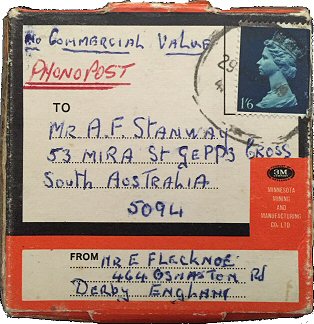Phonopost Rates 1966-1971

"Phonopost" was a class of mail introduced by the 1939 Buenos Aires UPU Conference, which offered a concessionary rate of postage for packets containing phonograph (gramophone) records, particularly intended for spoken messages. They had to be sent unsealed in strong packaging, which could have a note printed on the front to explain how to play the recording. (The records themselves were fragile and needed a special needle to play them, and it was permissible to enclose one of these in the package.) The service was extended to "tapes and wires" by the 1952 Brussels UPU Conference, taking effect 1st July 1953.
The service was always limited to countries which agreed to allow Phonopost packets at the concessionary rate, either in both directions or incoming only. Britain did not accept incoming packets until 1st January 1954 (see the British Commonwealth and Foreign Post Warrant 1953), and did not implement an outgoing service until 1st February 1966 following the 1964 Vienna UPU Conference, which allowed the printed explanatory notice to be an enclosure, and extended the service to "gramophone records and tapes, wires or other similar materials, whether or not bearing a sound recording" (presumably to cater for the sending of a blank tape for the addressee to record a message on).
The rules for GB packets were that Phonopost packets could contain or bear nothing except the above, any required customs declaration, and the names and addresses of the sender and addressee. They had to be clearly marked "PHONOPOST" in capital letters above the address, and had to be packed so as to allow examination. Airmail rates were slightly more expensive than for the usual second-class airmail.
The outgoing service was, however, short-lived as the 1969 Tokyo UPU Conference agreed to withdraw the Phonopost concession, along with that for samples. This took effect on 1st July 1971. After this, items which would have been transmissible by Phonopost were charged at the letter rate if they were recordings of personal messages, otherwise they were transmissible as small packets.
| Date | Zone A | Zone B | Zone C |
|---|---|---|---|
| 1966 (1 Feb) |
6d - ½oz 1s - 1oz 1s 6d - 1½oz 2s - 2oz 2s 6d - 2½oz 3s - 3oz 3s 6d - 3½oz 4s - 4oz Each addl. ½oz up to 2lb - 6d |
7d - ½oz 1s 2d - 1oz 1s 9d - 1½oz 2s 4d - 2oz 2s 11d - 2½oz 3s 6d - 3oz 4s 1d - 3½oz 4s 8d - 4oz Each addl. ½oz up to 2lb - 7d |
8d - ½oz 1s 4d - 1oz 2s - 1½oz 2s 8d - 2oz 3s 4d - 2½oz 4s - 3oz 4s 8d - 3½oz 5s 4d - 4oz Each addl. ½oz up to 2lb - 8d |
| 1966 (3 Oct) |
7d - ½oz 1s 2d - 1oz 1s 9d - 1½oz 2s 4d - 2oz 2s 11d - 2½oz 3s 6d - 3oz 4s 1d - 3½oz 4s 8d - 4oz Each addl. ½oz up to 2lb - 7d |
8d - ½oz 1s 4d - 1oz 2s - 1½oz 2s 8d - 2oz 3s 4d - 2½oz 4s - 3oz 4s 8d - 3½oz 5s 4d - 4oz Each addl. ½oz up to 2lb - 8d |
9d - ½oz 1s 6d - 1oz 2s 3d - 1½oz 3s - 2oz 3s 9d - 2½oz 4s 6d - 3oz 5s 3d - 3½oz 6s - 4oz Each addl. ½oz up to 2lb - 9d |
| 1971 (15 Feb) |
3p - ½oz 6p - 1oz 9p - 1½oz 12p - 2oz 15p - 2½oz 18p - 3oz 21p - 3½oz 24p - 4oz Each addl. ½oz up to 2lb - 3p |
3½p - ½oz 7p - 1oz 10½p - 1½oz 14p - 2oz 17½p - 2½oz 21p - 3oz 24½p - 3½oz 28p - 4oz Each addl. ½oz up to 2lb - 3½p |
4p - ½oz 8p - 1oz 12p - 1½oz 16p - 2oz 20p - 2½oz 24p - 3oz 28p - 3½oz 32p - 4oz Each addl. ½oz up to 2lb - 4p |
